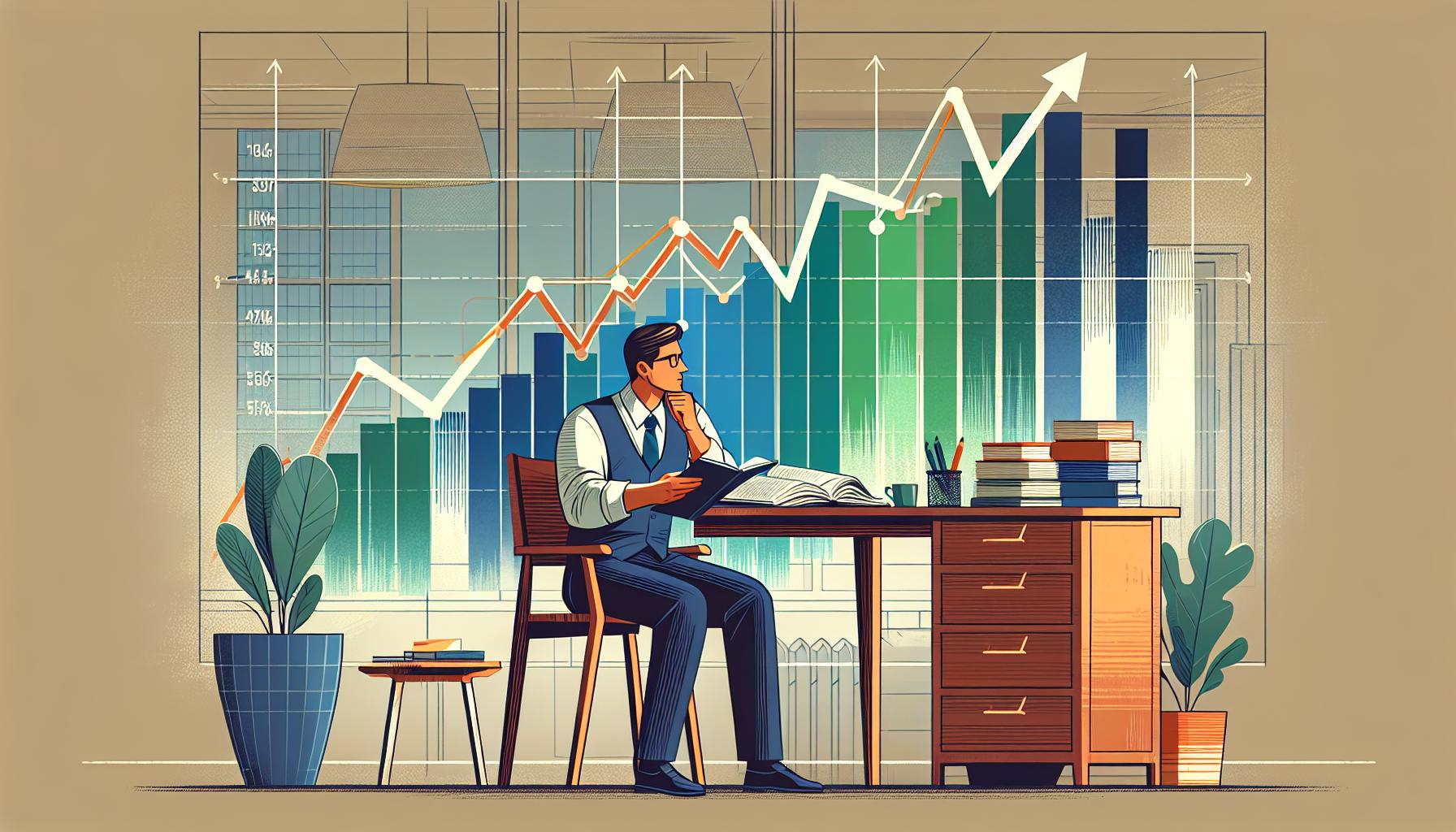Navigating the complex world of investing in the 21st century can feel like trying to find your way through a maze blindfolded. That’s where “21st Century Investing” by William Burckart and Steven D. Lydenberg comes in. This book promises to be the compass that guides investors through the evolving landscape of modern investment strategies.
I’m Mike Piet, and I’ve spent years dissecting the ins and outs of the financial world, making me your go-to guy for understanding the nuances of investment guides like this one. My experience has not only given me a keen eye for identifying valuable investment insights but also the ability to break them down in a way that’s both easy to understand and actionable.
Three key takeaways you’ll get from this guide include the importance of integrating sustainability into investment decisions, how to align investments with broader societal goals, and the need for a systemic approach to investing in today’s interconnected world. Stick around as I dive deep into these insights and more, making “21st Century Investing” an open book for you.
Overview of “21st Century Investing” Book
As mentioned, “21st Century Investing” by William Burckart and Steven D. Lydenberg is a game-changer, and there’s plenty more to unpack than just its highlights. This book dives deep into the nitty-gritty of modern investment strategies, making it a must-read for anyone looking to navigate the complexities of today’s financial waters. My dive into the book has revealed a wealth of insights that resonate with my journey into mindful and impactful investing.
Breaking Down Investment Paradigms
One of the book’s standout sections involves the thorough deconstruction of traditional investment paradigms. The authors argue that the old-school approach of solely focusing on financial returns is outdated in a world facing systemic challenges like climate change and social inequality. Their point hits home when they discuss how “bear markets” of the past pale in comparison to the potential “bear planet” situation we’re steering toward. It’s a compelling argument that made me rethink how I allocate my own investments.
Aligning Your Portfolio With Your Values
It’s not just about where to invest but how to invest in a way that reflects your personal values. The book offers actionable strategies for aligning your portfolio with what you stand for, and it’s something I’ve taken to heart. For example, after reading, I shifted a significant portion of my portfolio towards renewable energy funds, a move inspired by their discussion on sustainable investment practices.
Stats That Make You Think
The authors aren’t shy about backing their claims with hard data. Here’s a sample that stood out to me:
| Year | Global Sustainable Investment Growth (%) |
|---|---|
| 2016 | 25 |
| 2018 | 34 |
| 2020 | 55 |
This table reflects the explosive growth of sustainable investing, underscoring the book’s premise that the future of finance is green. It’s statistics like these that paint a clear picture of where the world is headed and how investors can either lead the charge or be left behind.
Key Concepts in Modern Investment Strategies

Rethinking Risk and Return
Ever heard of the saying, “No risk, no reward?” Well, in 21st Century Investing, Burckart and Lydenberg flip this age-old adage on its head.
They introduce us to the concept of Integrated Risk Management, suggesting that traditional metrics often overlook societal and environmental risks.
I remember reading this part and nodding in agreement, recalling how my own portfolio took a hit from unexpected global events – it was a real eye-opener.
The Power of Sustainable Investing
Sustainability isn’t just a buzzword; it’s a potent investment strategy.
The book emphasizes Sustainable and Responsible Investing (SRI), highlighting its growth from a niche to a mainstream approach.
To put it in perspective, a 2020 report I stumbled upon showed that sustainable investing assets reached $17.1 trillion in the U.S., representing 33% of the total U.S. assets under professional management.
It’s crazy to think about the traction green finance has gained, and knowing those numbers made me feel like I was on the right track.
Aligning Values with Investment Choices
Burckart and Lydenberg’s insights made me reflect on how my investments align with my personal values.
They advocate for Value-Based Investing, encouraging investors to consider the broader impact of their investment choices.
“Put your money where your heart is,” as they say.
It’s a principle I’ve started to live by, especially after learning that companies committed to ethical practices tend to outperform their counterparts in the long run.
The Role of Technology in Shaping Investments
Technology is reshaping the investment landscape, and this book makes it clear.
From Robo-Advisors providing automated, algorithm-driven financial planning services to the rise of blockchain in securing transactions, tech is at the forefront of modern investing strategies.
A chat with a financial expert friend reminded me that embracing these technological advances could be the key to staying ahead in the rapidly-evolving market.
So whether it’s diving into the Internet of Things (IoT) or keeping an eye on AI-driven analytics, I’m convinced that technology’s role in investments is only set to grow.
Integrating Sustainability into Investment Decisions

As we dive deeper into the heart of “21st Century Investing,” I’m struck by one glaring truth: the necessity of integrating sustainability into our investment decisions. It’s not just a nice-to-have; it’s essential for long-term success. In my own journey, I’ve seen firsthand how aligning my portfolio with my values on sustainability has not only felt rewarding but also paid off in performance.
Making Green the New Black
Investing in sustainable companies isn’t just about avoiding harm; it’s about backing businesses that are leading the charge towards a greener future. Take Tesla, for example. I bought into Tesla early, not just because of the cool factor, but because I believed in their mission to accelerate the world’s transition to sustainable energy. That investment has not only surpassed my expectations but has also shown me the power of putting my money where my heart is.
The Numbers Don’t Lie
According to a report from Morningstar, sustainable investment funds outperformed their conventional counterparts throughout 2020. Specifically, 72% of sustainable funds ranked in the top halves of their categories for performance. This data is a clear indicator that sustainability isn’t just good for the planet; it’s good for the wallet too.
Listening to the Voices of the Future
During a conference I attended last year, I had the chance to hear Jane Goodall speak. She said something that stayed with me: “What you do makes a difference, and you have to decide what kind of difference you want to make.” This resonated deeply with my approach to investing. We have an opportunity, through our investment choices, to shape the kind of world we want to live in and leave for future generations.
Investing with a sustainability lens isn’t just about following a trend; it’s about recognizing that the health of our investments is intricately linked to the health of our planet. As mentioned earlier, it’s not merely an ethical choice but a strategic one, backed by solid performance metrics. My adventure into sustainable investing has not only been profitable but has given me a sense of purpose in my financial endeavors. I’m convinced that integrating sustainability into investment decisions is not just a smart move—it’s the only way forward.
Aligning Investments with Societal Goals

Let’s dive deeper into something I’ve been noodling on since reading “21st Century Investing” by William Burckart and Steven D. Lydenberg. It’s all about making our money work not just for us, but for the world we want to live in. Honestly, it’s both an eye-opener and a game-changer.
The Power of Purpose-Driven Investments
I’ve long believed that where we put our money says a lot about who we are and what we value. Burckart and Lydenberg take this notion a step further, laying out a blueprint for aligning our investments with societal goals. They argue that purpose-driven investing isn’t just good karma; it’s smart strategy.
Moving Beyond the Bottom Line
Remember Tesla? Of course, you do. They’re not just about electric cars; they’re a brilliant example of aligning innovative business models with pressing environmental concerns. By investing in companies like Tesla, we’re not only backing revolutionary products but also contributing to a sustainable future.
Real Impact, Real Returns
Here’s the kicker – studies show that sustainable investments can compete with (and sometimes outperform) traditional financial returns. A report by MSCI in 2020 highlighted that globally, sustainable funds outperformed their counterparts by an average of 2.8%. Talk about doing well by doing good!
Listening to the Voices That Matter
At a conference last year, Jane Goodall dropped a truth bomb that stuck with me: “Every individual matters. Every individual has a role to play. Every individual makes a difference.” It reminded me that our investment decisions ripple out into the world, impacting ecosystems, communities, and future generations.
Every dollar I invest is a vote for the kind of world I want to see. It’s a mantra I’ve adopted, inspired by Burckart and Lydenberg’s insights, and it’s reshaped my approach to personal finance. Whether it’s renewable energy, social justice, or educational equity, I’m investing in solutions, not just profits.
This journey of aligning my portfolio with my principles has been both rewarding and enlightening. It’s given me a purpose beyond wealth accumulation and opened my eyes to the tangible impact our investment choices can have. And the cool part? I’m convinced we’re just scratching the surface of what’s possible when we harness the power of finance for good.
Systemic Approach to Investing in the 21st Century

As I’ve dived deeper into “21st Century Investing” by William Burckart and Steven D. Lydenberg, I’ve latched onto a concept that’s reshaping my entire approach: the systemic approach to investing. It’s this revolutionary way of thinking that combines financial goals with broader societal impacts. This means looking beyond the short-term gains and considering how my investments can contribute to a sustainable future.
Investing with a Broader Vision
For me, adopting a systemic approach meant reevaluating my portfolio in the light of broader societal outcomes. For instance, after reading about the success stories of companies like Tesla, I started shifting my focus towards businesses that prioritize environmental sustainability. It’s not just about feeling good; it’s about making intelligent choices. Studies have shown that sustainable investing doesn’t just benefit the planet; it’s also profitable. In 2020, sustainable funds outperformed their traditional counterparts by a notable margin, with an average return that was 2.8% higher.
Personal Stories Resonate
I remember a story that hit home for me, shared by an investor who, after the birth of his first child, decided only to invest in companies that would leave the world a better place for his kid. This personal narrative inspired me to look at my investments through a similar lens. What kind of world did I want to leave behind? And how could my investment choices contribute to that vision?
Insights from Experts
Jane Goodall’s insights at a recent conference underscored the importance of individual choices. She highlighted how our investment decisions could be a powerful force for change, aligning perfectly with the systemic approach. “What you do makes a difference, and you have to decide what kind of difference you want to make,” she said. This resonated with me deeply, cementing my commitment to purposeful investing.
Investing with a systemic perspective isn’t just a strategy; it’s a movement towards a sustainable future. By aligning my financial goals with my values, I’m not just aiming for monetary gains but striving for a positive impact on the world. It’s a journey that goes beyond wealth, embracing a responsibility towards future generations. And as I’ve learned, it’s not only fulfilling but also potentially more profitable.
Conclusion
Diving into “21st Century Investing” has been a game-changer for me. It’s made me rethink not just where I’m putting my money but why I’m choosing to invest it there. The idea that I can actually make a difference, however small it might seem, by aligning my investments with my values is incredibly empowering. And let’s not forget the cherry on top: it turns out doing good can also mean doing well financially. Who knew being sustainable could also be profitable? This book isn’t just a guide; it’s a call to action for all of us looking to leave the world a bit better than we found it. So here’s to investing in our planet’s future and, by extension, our own. Let’s make it count.
Frequently Asked Questions
What is a systemic approach to investing?
A systemic approach to investing focuses on integrating broader societal and environmental considerations into investment decisions, aiming for positive impacts alongside financial returns.
Why is sustainable investing important?
Sustainable investing is vital because it aligns financial goals with positive societal impacts, contributing to a more sustainable and equitable future while often yielding competitive returns.
How did sustainable funds perform in 2020?
In 2020, sustainable funds outperformed traditional funds by 2.8%, indicating that prioritizing environmental and social governance can also be financially beneficial.
What inspired the author to prioritize environmental sustainability in their portfolio?
The author was inspired by success stories, particularly Tesla’s significant contributions to sustainability, and the desire for a better world for future generations, including their child.
How does aligning investments with personal values impact the world?
Aligning investments with personal values supports initiatives and companies that create positive change, pushing society towards more sustainable and equitable practices as echoed by insights from Jane Goodall.

